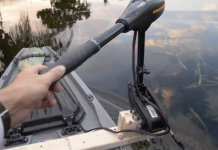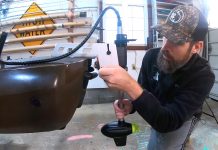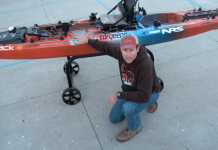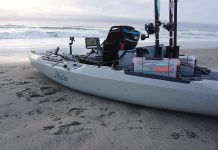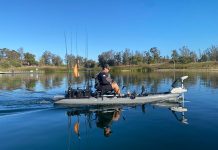No one knows how soon after the invention of the standup paddleboard someone took one fishing. But for BOTE pro Harry Madison and other SUP anglers, the shallow draft, lightweight and stable boards are perfect for fishing the flats. “Anything that involves sight fishing is perfect for a paddleboard,” he says.
Madison spends most of the year chasing redfish in southwest Florida’s backwaters and creeks, but in June and July, he turns his attention to the Gulf of Mexico for tarpon. “Nothing beats the mobility and stealth of a paddleboard,” he affirms. Read on for his expert SUP rigging tips.
Ultimate Rigging Guide for SUP Fishing
Fishing Paddleboard
Standup paddleboards have grown long and wide to accommodate a fisherman and his gear. But paddling a board shaped like a plank is difficult and inefficient. To carry tackle and gear, Harry Madison uses BOTE’s 14-foot Rackham hybrid SUP.
“The HD hull tracks better with less effort,” he says. The hull features a flared bow to cut through the waves and a slight keel for straight tracking. Madison adds, “It has high volume to can carry me and my gear easily.” The deck is padded for standing all day. High rails and a convex bow shed waves and spray.
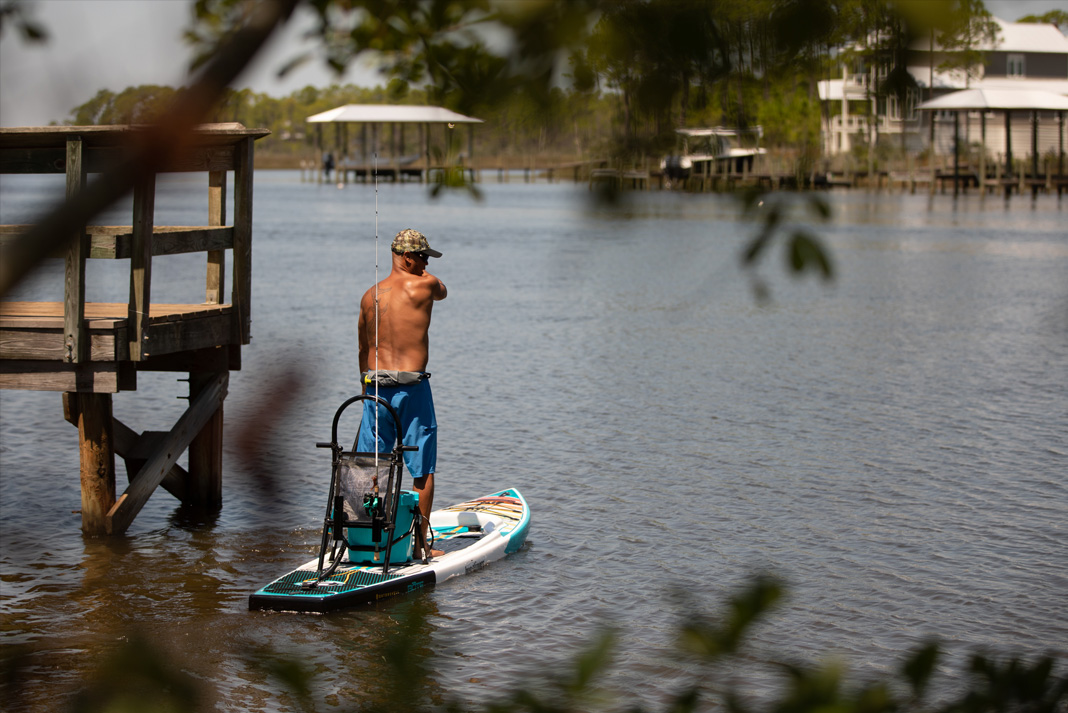
A hard board is rigid with a smooth surface to improve efficiency and stability. The glass board will not flex to absorb paddling power. And, the polished surface passes through the water with less resistance. Hard boards can be fragile, but BOTE uses Gatorshell composite plastic that is six-times stronger than their traditional epoxy boards.
Standup paddleboards are easy to store, transport and launch. The shallow draft can sneak into areas too skinny for a kayak. But standup paddleboards are not as easy as a kayak to paddle. Their range is generally less than a kayak, too. The long paddle shaft and high paddling angle make the boards inefficient and awkward compared to the lower position and double-bladed kayak paddle, but the BOTE Rackham is designed for fishing adding comfort touches like padded deck, leaning posts and even a cooler that doubles as a seat.
Paddle or Pedal
For the most powerful stroke, Madison uses a once-piece paddle sized to his paddling style. “The BOTE Axe Bugslinger is my stick,” he says. The shaft is lighter with less flex to transfer more paddling power to the water.
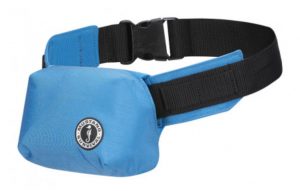 SUP Life Vest
SUP Life Vest
To improve range of motion and reduce bulk and weight, standup paddleboarders prefer inflatable life vests. A belt-worn inflatable is less restrictive, allowing the angler to twist at the waist and keep his paddle close to the board for the most efficient stroke.
Accessories
“I only carry a dehooker and pair of pliers,” Madison insists. To hold his kayak in shallow water, he uses a stakeout pole and BOTE’s Pole Holder. Throw on the brakes by threading the pole through the holder and spear it into the sand.
VIEW ALL STAKEOUT & PUSH POLES
Tackle Storage
 Everything on a SUP will get wet, and reduced stability increases the probability an angler and his gear could end up in the water. “Less is best for me,” Madison says. He uses sealed tackle trays with a rust-restricting element. The trays are made with plastic that emits a chemical coating on hooks and swivels.
Everything on a SUP will get wet, and reduced stability increases the probability an angler and his gear could end up in the water. “Less is best for me,” Madison says. He uses sealed tackle trays with a rust-restricting element. The trays are made with plastic that emits a chemical coating on hooks and swivels.
Madison carries two boxes, “One with soft plastics and the other with hard plastics,” he says. He secures the tackle trays to the SUP with a Tackle Webs bag.
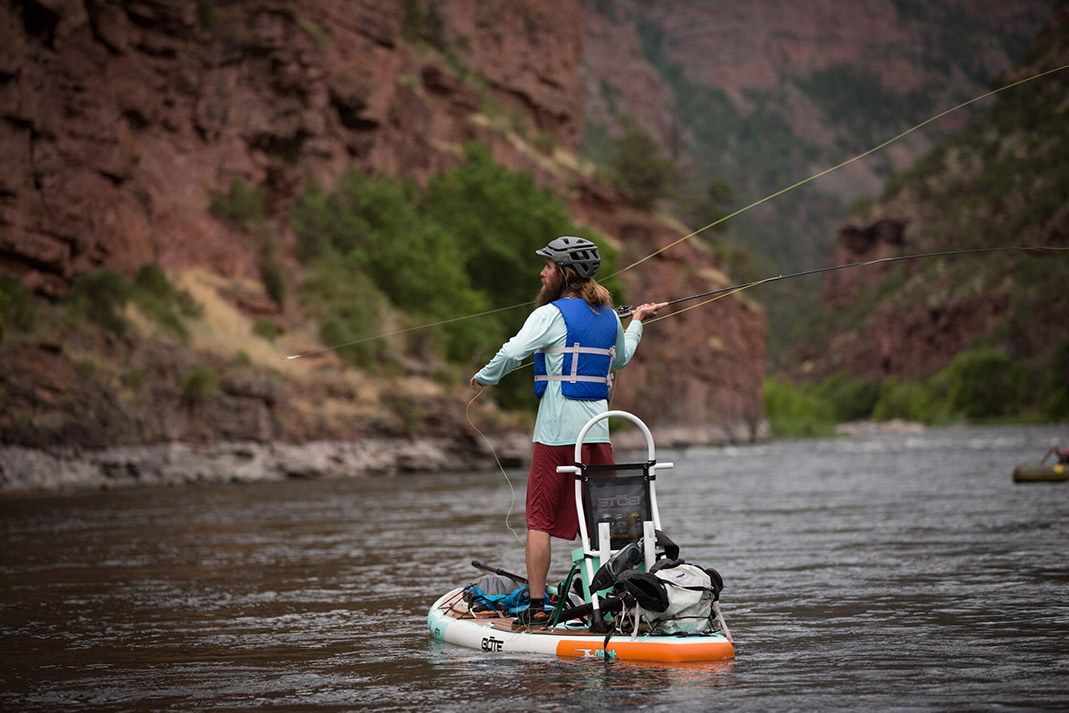
Paddleboard Crate
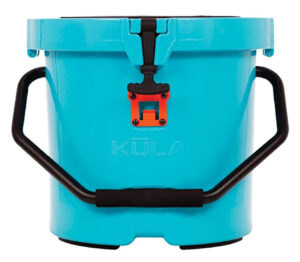 BOTE offers a versatile line of accessories to match their boards. Madison chooses a rod rack and Kula cooler. “I can carry four rods so I don’t have to waste time changing lures,” he says. The bucket-shaped Kula offers dry storage or fish storage. “I can even use it as a seat,” he says.
BOTE offers a versatile line of accessories to match their boards. Madison chooses a rod rack and Kula cooler. “I can carry four rods so I don’t have to waste time changing lures,” he says. The bucket-shaped Kula offers dry storage or fish storage. “I can even use it as a seat,” he says.
“Keep fishing rods in reach,” Madison insists. Moving around on a SUP seems simple but is actually somewhat precarious. And a fish will slip out of sight in a second. “I can grab a rod without taking my eyes off the water.”
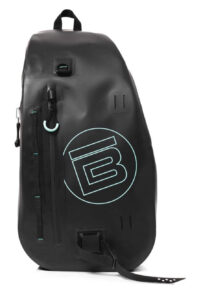 Dry Storage
Dry Storage
Madison uses a BOTE Sling waterproof backpack to hold drinks and food with some extra storage. He can throw the bag over his shoulder to walk his board to the beach, then leave it on the deck without the contents getting wet. He can even wear it while fishing, the one-shoulder sling and top-opening zipper are easy to access.
SUP Fishing Apparel
The only protection between a kayak angler and Mother Nature is the angler’s apparel. Sun, wind, spray, cold and heat are a constant threat, even on a nice day.
Fortunately, anglers have access to technologically advanced clothing capable of warding off the elements. The number one obstacle to fishing is the weather. With the right clothes, an angler will spend more time on the water.
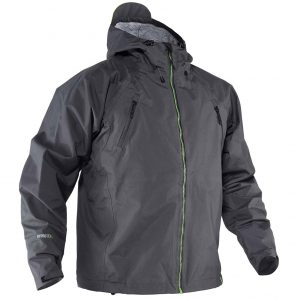 Outerwear
Outerwear
Your mother was right, the best way to stay warm, dry and cool is by dressing in layers. The outer layer is probably most important. Protecting the angler from the elements requires a layer that can repel water, block wind and still release body heat.
Waterproofing is achieved two ways. Rubber-coated cloth completely blocks the wind and rain. These outerwear choices are worn by commercial watermen in the worst conditions. However, rubber rain gear will not exhale body heat causing moisture to collect on the inside.
Breathable fabrics use three layers of material. The inner layer wicks moisture, the middle layer passes it to the outer layer where it is expelled through tiny holes. The outer layer is coated with a chemical to keep rain and spray from entering. This system is cooler and more comfortable, but breathable fabrics can fail and need to be maintained.
Waders are a common choice for cold-weather, but the clunky boots are cumbersome and a high waist and heavy material aren’t ideal for sitting in a kayak. Neoprene waders are more comfortable, but they are not as wind-resistant as breathable waders.
For spring and fall, a pair of paddling pants are most comfortable. In the winter, anglers go for bibs or a drysuit for extra protection. For the ultimate in safety and warmth, a drysuit is sealed at the neck and wrists to protect the wearer.
Even during the summer, an angler should carry a lightweight outer layer ready for thunderstorms and wind-whipped spray. A rain jacket and pants stuffed in a drybag will prevent hypothermia on a warm night.
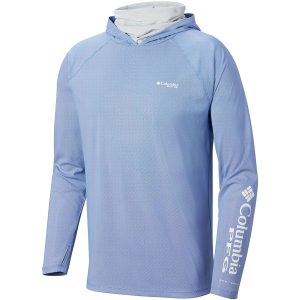 Mid Layer
Mid Layer
In cold seasons, the mid layer wicks moisture away from the skin and passes it to the breathable outer layer. A lofty, fluffy material will capture warmth while releasing moisture. The mid layer should have a snug fit to take up less space.
Base Layer
The base layer has one purpose: expel moisture. Thin, light and stretchy, a good base layer moves with the wearer. Combined with a warm mid layer and waterproof outer layer, the base layer completes the system by managing heat and vapor.
During warm weather, the base layer turns to sun protection. A light, breathable, quick drying and ventilated long sleeve shirt and long pants are more protective than sun block. Combine the base layer with sun gloves, a wide brim hat and neck gator, and the angler will be protected from harmful UV rays.
Finally, water shoes or neoprene booties will keep feet in the shade and protect from injury. In a kayak, any exposed skin is subject to extreme sunburn.
VIEW ALL HANDWEAR VIEW ALL FOOTWEAR
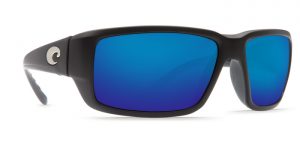 Sunglasses
Sunglasses
Sunglasses are more than cool. High-quality polarized lenses protect against UV light and help the angler see through glare on the water. Glass lenses are clearer, sharper and scratch resistant but they are also heavier. Polycarbonate lenses are shatterproof and lighter.
In clear, blue water, anglers prefer a grey lens. Amber or copper lenses bring out details in green or stained water. For low light conditions, a yellow lens will increase brightness and contrast.
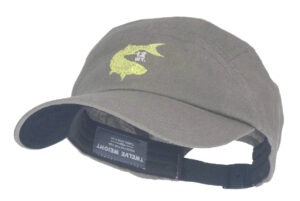 Hat
Hat
Probably the most important piece of outwear is a lucky fishing hat. Breathable fabric and sweat-blocking band will protect an angler from the sun. A dark brim cuts glare to protect the eyes. A wide brim is great against the sun and rain, but it will catch the wind.
This article was first published in Kayak Angler Issue 43. Subscribe to Kayak Angler’s print and digital editions here, or browse the archives here.
Rig your SUP for sight fishing. | Feature photo: Courtesy BOTE


